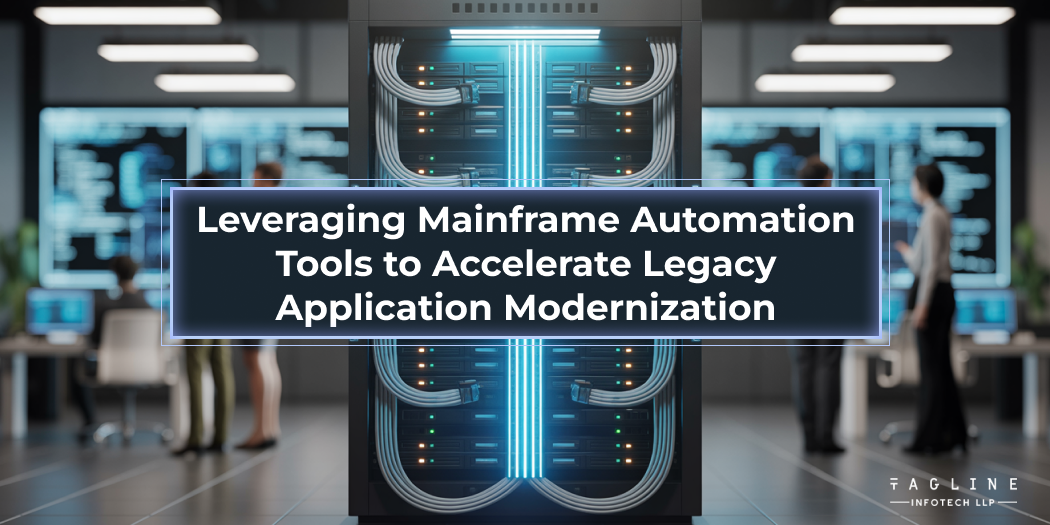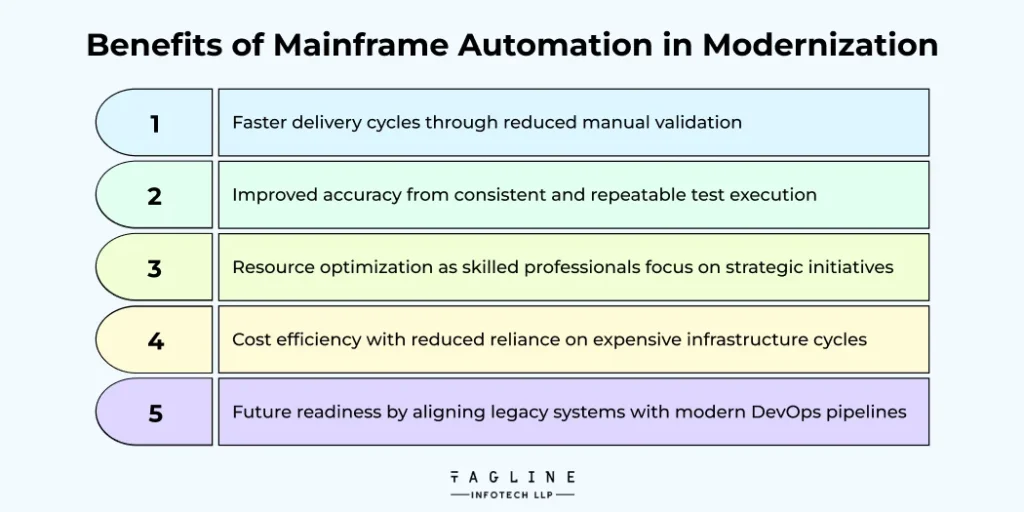Role of Python Libraries in Image Processing
October 30, 2025
Home >> Testing >> Leveraging Mainframe Automation Tools to Accelerate Legacy Application Modernization

Legacy applications continue to serve as the backbone of many enterprises across industries such as banking, healthcare, manufacturing, and government. These systems, often built decades ago, remain reliable but pose significant challenges when businesses pursue modernization. The challenges range from maintaining aging infrastructure to addressing the talent gap in legacy programming skills. Despite these issues, organizations hesitate to replace mainframes completely due to their unmatched performance and resilience. Instead, the solution lies in modernization strategies that preserve core functionality while improving agility, usability, and integration with modern platforms.
A critical factor in enabling this transition is automation. By combining human productivity signals such as collaboration, decision making, and workflow efficiency with advanced mainframe automation tools, enterprises can accelerate the modernization journey while mitigating risks. Automation not only reduces manual effort but also ensures consistent testing, validation, and monitoring across systems that are otherwise difficult to manage.
This article explores how mainframe automation tools drive modernization, the role of human productivity signals in shaping strategies, and how enterprises can balance legacy reliability with the need for innovation.
Legacy applications hold vast amounts of business-critical data and processes. However, they present issues such as:
These factors not only create technical debt but also restrict innovation across the enterprise. Legacy systems often operate in isolation, making integration with modern digital tools or customer-facing platforms extremely difficult. As organizations grow, the inability to scale these applications efficiently results in operational bottlenecks, higher risks of downtime, and mounting expenses. Modernization is no longer a luxury but a necessity to remain competitive. It enables enterprises to adapt to customer expectations, regulatory changes, and digital transformation initiatives while also building a foundation for long-term resilience and agility.
While modernization brings promise, it also comes with risks:
These challenges highlight the need for a structured approach to modernization that balances stability with progress. Without the right planning and automation support, enterprises risk stalled projects, frustrated teams, and costly rework that diminishes the value of modernization efforts.
Human productivity signals represent the measurable indicators of efficiency and collaboration in enterprise teams. When applied to modernization, these signals provide insights into how people interact with systems, processes, and one another. They serve as a compass for directing automation efforts in the right areas. By understanding where teams thrive and where they struggle, enterprises can make informed decisions about where automation delivers the most impact.
Examples include:
These signals provide real-world evidence of how modernization initiatives affect productivity. For instance, if automation reduces resolution time or increases detection rates, the organization gains measurable proof of success. Over time, these metrics form the basis of continuous improvement by helping leaders adjust strategies, optimize processes, and better allocate resources. By blending these signals with automation strategies, enterprises can identify bottlenecks, enhance workflows, and ensure modernization projects align with business goals and measurable outcomes.
Mainframes power essential business processes but are inherently complex. Manual testing and maintenance can be slow, error-prone, and resource-intensive. This reality often limits innovation and slows down modernization efforts. Mainframe test automation tools solve these problems by:
Beyond these immediate benefits, automation also improves scalability and consistency across projects. It allows enterprises to handle large volumes of transactions with greater confidence while reducing operational risks tied to human error. Automated frameworks provide visibility into processes that were once opaque, helping leaders make better strategic decisions. With tools like testRigor, enterprises can transform testing by enabling plain English scripting, broader team participation, and integration with modern development pipelines, all while freeing teams to focus on innovation rather than repetitive manual tasks.
Modernization is not just about automating tasks but aligning automation with human-driven insights. By weaving human productivity signals into automation strategies, organizations create a more adaptive and intelligent approach to modernization. Instead of viewing automation as a replacement for human effort, it becomes a force multiplier that amplifies decision-making and collaboration. Here’s how organizations can combine the two:
Human productivity signals reveal where delays occur, whether in test case creation, defect resolution, or release approvals. Automation can target these areas for maximum impact, ensuring teams spend less time on repetitive bottlenecks and more time on innovation.
Automation ensures repetitive tasks are handled consistently, while human teams focus on exploratory testing and high-level decision-making. This balance increases overall coverage and quality, providing a stronger safety net for modernization initiatives.
Human productivity data highlights gaps in communication. Automation tools integrate with collaboration platforms to ensure transparency across QA, development, and operations teams. This creates shared accountability and smoother workflows across departments.
Signals such as error frequency and time to resolution help identify high-risk areas. Automation can then prioritize these areas, ensuring critical functions are thoroughly validated. Over time, this targeted approach improves reliability and strengthens confidence in modernization outcomes.

Enterprises adopting automation for modernization projects can expect the following benefits:
Ultimately, these benefits compound to create a competitive advantage. Organizations not only reduce risks but also position themselves to innovate faster, respond to market demands, and maintain stability while modernizing core business operations
Across industries, these use cases demonstrate how mainframe automation provides measurable improvements in efficiency, compliance, and reliability during modernization efforts
When selecting tools, enterprises should look for:
Beyond these essentials, organizations should also consider the long-term adaptability of their chosen solution. The best tools provide flexibility to integrate with evolving technology stacks, ensuring modernization efforts are not stalled by future upgrades. Strong reporting and analytics capabilities are also vital, as they allow leaders to measure progress and demonstrate value to stakeholders. Security should never be overlooked, especially in industries such as banking and healthcare, where compliance requirements are strict. TestRigor stands out by offering plain English automation, strong mainframe support, and the ability to unify testing across multiple platforms while keeping ease of use at the center of its design.
As enterprises increasingly rely on hybrid systems combining mainframes with cloud native applications, automation will play an even greater role. The next wave of innovation lies in AI-driven predictive analytics, where systems proactively detect risks and recommend optimizations. Human productivity signals will evolve into actionable intelligence, making modernization strategies more adaptive and resilient.
In addition, the convergence of automation with machine learning will create self-healing systems that automatically adjust to errors without human intervention. Enterprises will also see closer integration of automation with cloud orchestration tools, enabling seamless scalability across diverse environments. Security testing will become an embedded part of automation frameworks, ensuring compliance is maintained even as systems evolve. As workforce dynamics change, automation will empower both technical and non-technical professionals to contribute to testing and modernization, democratizing enterprise transformation and accelerating innovation cycles for years to come.
Legacy systems will continue to remain integral to enterprises, but modernization is critical to achieving agility, innovation, and competitiveness. By blending human productivity signals with the power of mainframe automation tools, organizations can streamline modernization while minimizing risks. Automation not only reduces manual effort but also ensures accuracy, compliance, and speed, which are essential for successful transformation.
The combination of human insights and advanced automation ensures that enterprises do not just modernize for today but prepare for a future where adaptability defines success. Organizations that embrace this dual approach gain the ability to innovate faster, deliver better customer experiences, and remain resilient in the face of change. As business environments grow increasingly dynamic, modernization guided by productivity insights and enabled by automation will serve as a strategic advantage. In this way, enterprises protect the value of their legacy systems while unlocking new possibilities for growth, scalability, and long-term sustainability.
Automation reduces manual effort, accelerates testing, improves accuracy, and enables integration with modern DevOps practices. It ensures consistency across environments and helps mitigate risks during migration or transformation.
Human productivity signals—such as collaboration efficiency, decision-making speed, and error resolution rates—help identify where automation has the most impact. They guide enterprises in aligning modernization strategies with measurable improvements in team performance.
No. While testing is a core use case, automation tools also support monitoring, compliance validation, workflow orchestration, and integration with APIs and cloud systems. They streamline end-to-end modernization efforts.
Created with Solvase

Digital Valley, 423, Apple Square, beside Lajamni Chowk, Mota Varachha, Surat, Gujarat 394101
D-401, titanium city center, 100 feet anand nagar road, Ahmedabad-380015
+91 9913 808 2851133 Sampley Ln Leander, Texas, 78641
52 Godalming Avenue, wallington, London - SM6 8NW